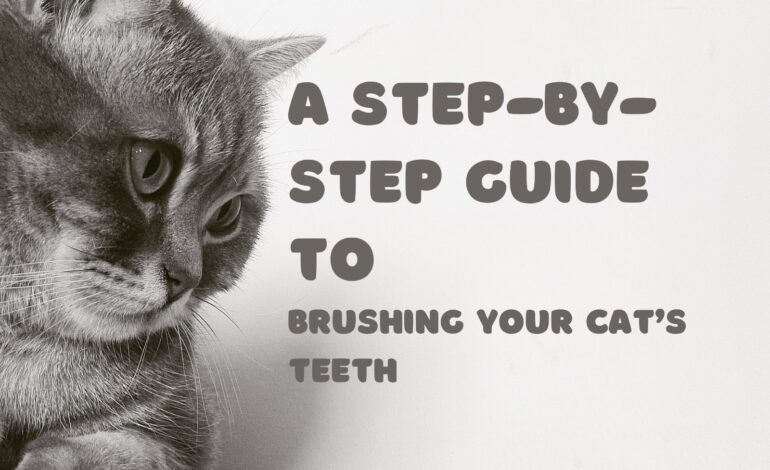A Step-by-Step Guide to Brushing Your Cat’s Teeth

Do you think that your cat’s teeth are fine because they still eat and purr? The reality is that dental disease in cats is incredibly underreported and only acknowledged after it is in later stages—at which point in time it can certainly do damage. Estimates show that anywhere between 50 and 90 percent of cats aged four or older will have developed dental disease and some research estimates that around 70 percent will already be affected at age 2.(1) Ignoring these problems does not only mean the presence of painful gums and the probability of losing teeth; it is also associated with chronic kidney disease and other organ problems that relate to the heart and liver.
That is also the reason that worrying about your cat’s appearance is to some degree irrelevant. In reality it is some of the best preventive action you can take. This guide is also intended to teach people to best brush the teeth of a cat. It will provide a step by step explicit logic as to why it is essential and will offer suggestions on how to do it in a way that is best suitable for both the human and the cat.
Why Brushing Your Cat’s Teeth Is Important?

- Prevents dental disease. Plaques formed on teeth will harden and become tartar in 36 and 48 hours. Untreated plaque can cause gingivitis in 2 to 3 weeks. However, plaque formation can be reduced significantly through brushing and lowered disease risk.(2)
- Catches problems early (including tooth resorption). Tooth resorption is a disease that catches people by surprise. Resorptive lesions are considered quite common in felines, especially in a certain breed population. With brushing, regular dental checks allow swift identification of unusual structures, and a range of other pathologies. (3)
- Helps freshen breath and oral comfort. Relaxation of the dental tissues can be aided. Oral hygiene of the entire mouth has effects on hygiene. Brushing teeth halitosis from the mouth. Bad breath arises and becomes greater, the more plaque is positioned.
- Protects overall health. Many studies connect serious periodontal disease in cats with higher risk of systemic issues (especially chronic kidney disease); chronic infection and inflammatory processes as well as oral cavity bacteria provide mechanisms for organ involvement and interest.
- Saves money in the long run. Home care is tremendously valuable for cost containment. Professional dental cleaning and dental extractions are costly to the practitioner (in primary care setting routine cleaning appointments commonly begin in the lower hundreds). Home care lowers the risk of expensive procedures.
Getting Started: Supplies You’ll Need
- Cat-specific toothbrush — small head toothbrush with soft bristles (or a Child-size soft toothbrush. Each ~3 months replacement is mandatory. One toothbrush per cat. (4)
- Cat toothpaste (enzymatic, pet flavors) — Choose a VOHC accepted enzymatic paste (poultry or fish flavours aid acceptance) for cat toothpaste (enzymatic, pet flavours). Human toothpaste is a big no no (fluoride/xylitol risks); pet pastes are formulated to be safely swallowed.
- Finger brush (optional starter tool) — serves to introduce taste/feel gently, but is best replaced with a small soft bristle brush as vets find it better for mechanical plaque removal.
- Small, tasty rewards — brushing immediately is positive reinforcement for better association. Daily brushing is best, but brushing several times a week helps as well.
- Backup options — VOHC listed dental wipes, water additives, or dental diets are available for non brushing days (Wipes do remove biofilm but less effectively than brushing).
Step-by-Step Guide: How to Brush a Cat’s Teeth
Step 1: Introduce Toothpaste Slowly
- Put about a pea-size amount of pet-approved enzymatic toothpaste on your finger.
- Most cats like poultry or fish flavors so let your cat lick it off.
- Continue this for 3 to 5 days. As your cat gets more accustomed to new things, it may take longer to adapt.
Tip: Research shows enzymatic toothpastes can reduce plaque by 50–70% when paired with brushing, compared to brushing only.
Step 2: Familiarize Your Cat with the Toothbrush
- If the cat brush is your cat’s first toothbrush, let them sniff it, lick it, and chew on it a bit.
- If a cat is more resistant, take a piece of gauze, bend it around your finger, and use that to wipe early biofilm.
- Biofilm can form on teeth in about a day, so even gentle wiping is helpful in the beginning if brushing is not tolerated.
Step 3: Start with Gentle Touch
- Smear some toothpaste on your cat’s gums using your finger.
- Keep ‘training’ to about 10-20 seconds per day. Cats tend to learn better in tiny, gradual steps. Forcing longer sessions to start can create emotional scars and resistance to touch that last a lifetime.
- This part helps kittens or young cats to be more tolerant of being handled in the future.
Step 4: Begin Brushing
- Pick a warm and quiet place, as stress can raise a cat’s cortisol levels, leading to more resistance to touch.
- Slowly raise the lip so you can see the exposed teeth.
- Using the toothbrush, do small circles along the gums, starting on the outside of the upper canines and molars. That’s where a cat’s dental disease usually begins.
- Brush a little more each day to the point where you can brush most of their teeth.
Step 5: Reward & Repeat
- End every session with a reward—treat, petting, or a short play session. Positive reinforcement doubles compliance over time in cats compared to neutral handling.
- Aim for daily brushing, but even 3–4 times per week can significantly reduce gingivitis and periodontal disease risk.
Tips for Success
- Be patient: Progress takes time, especially with older or anxious cats.
- Keep sessions short: Even a few seconds of brushing is a win at the start.
- Never use human toothpaste: It contains fluoride and other ingredients that are toxic to cats.
- Don’t force it: Forcing will only cause fear and resistance—work at your cat’s pace.
- Combine with professional care: Even with regular brushing, schedule dental checkups with your vet to prevent hidden issues.
Check the video for visual explanation:
Alternatives If You Can’t Brush Your Cat’s Teeth

Some cats just won’t tolerate toothbrushing at all. In such cases, there are still alternatives to help with dental health.
- Dental Chews & Treats – Some treats are meant to help with plaque and tartar. The VOHC says some approved products can reduce plaque by up to 39% with consistent use.
- Water Additives – Some water modifiers reduce bacteria using enzymes that fight bad bacteria. One study discovered that plaque and tartar accumulation was reduced by 20-30% with certain modifiers.
- Dental Diets – The transformation of Prescription Diets like Hill’s® t/d™ or Royal Canin® Dental, captures unique dental kibble to support plaque control. These diets can reduce calculus buildup by over 40% when fed consistently.
⚠️ Important: These options are supportive, not replacements. Toothbrushing remains the gold standard for feline dental care, but these methods are still better than doing nothing.
Conclusion
If you have ever tried brushing a cat’s teeth you will understand that it often feels like you’re trying to wrestle an itty bitty fluffy gator .🐱🦷 As hard as it may seem, dental care is just as important for cats as it is for humans. Cats can suffer from plaque and tartar build up, even leading to bad breath and other serious health issues if their teeth are not ‘brushed’ regularly.
At Meow Care Hub, we understand that a happy cat is a cat with healthy teeth and we will show you that achieving it is not as difficult as it may seem. Turns out, brushing a cat’s teeth is not a strenuous, impossible task, rather a simple addition to your care routine that can be easily integrated with some consistency and the right approach.
👉 Want to eliminate the anxiety that comes with brushing cat’s teeth and replacing it with a ‘stress-free’ approach? As your cat’s dental caretakers, we at Meow Care Hub will let you follow our unique, simplified guide and let your cat show off the beautiful, healthy smile we know they have hidden.
FAQs About Brushing Your Cat’s Teeth
1. Do you need to brush cat teeth?
Yes. Regular brushing is the best way to prevent dental disease and protect your cat’s health.
2. How do I brush my cat’s teeth if they resist?
Start small. Let them lick toothpaste off your finger, use a finger brush, and build trust over time. Patience is key.
3. Can I use human toothpaste to brush a cat’s teeth?
No. Human toothpaste contains fluoride and xylitol, which are toxic to cats. Always use cat-specific toothpaste.
4. What’s the best way to brush a cat’s teeth?
Use a soft, cat-sized toothbrush and focus on the gumline with gentle circular motions. Keep sessions short and reward your cat.
5. How often should I brush my cat’s teeth?
Daily is ideal, but brushing at least 3–4 times a week still provides significant benefits.
6. Is it too late to start brushing an older cat’s teeth?
No. Older cats can learn with patience, though they may need extra time to get comfortable. Start slow and consult your vet if dental disease is already present.
Resources:





